September 14th
4:53 – 5:49 PM
78 degrees

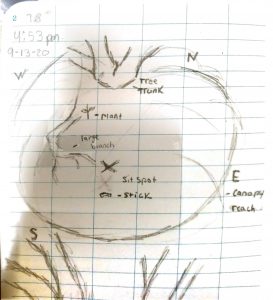
Hello, everyone!
For my journal I chose to observe the site of a large tree on the outskirts of campus. I chose this tree just as I was getting desperate for a good spot – I walked nearly entirely around campus and found many other interesting areas I hadn’t noticed before, but none seemed right. The tree stood out because of its size and view; and it happened to have the perfect place to sit just under its branches. It is located between the greenhouse and the stables with a view of pasture, mountains and a valley – but under the branches this view is almost entirely blocked out; under the tree, the seclusion gives the illusion of a completely isolated community. The canopy encloses a wide area around the trunk that’s about thirty feet in diameter. The branches of the tree reach nearly to the ground, some seem to have been intentionally cut back to prevent this. I am still researching the type of tree it may be – It is deciduous and seems to lack any fruits at this time of year. The leaves are narrow, heart shaped, entire, and smooth margined. Some leaves have already turned yellow and fallen; others barely cling to the lower branches, brown and dead. In fact, all of the lower branches of the tree are bare.
I found the spot and did my first observation last Sunday (September 14th) around five o’clock in the afternoon. I chose to sit under the tree about ten feet from its base and five feet from the edge of the reach of its branches, facing Northwest toward the trunk. The ground surrounding the tree is almost completely carpeted in large, vibrant green, clover-like plants. The sky, at least the patches that could be seen through a few gaps in the leaves, was bright blue with a few cirrus wisps. One of the main things I noticed that day were the insects, as they swarmed me when I sat down on the clover carpet beneath the canopy. The first swarm to investigate me were tiny white bugs that mostly flew around me, but also landed and jumped frequently. After a few minutes they went away and were replaced by mosquitoes. In the treetop I could hear occasional cicadas and many other insects I was unable to identify; they created a constant low buzz throughout the hour. I also heard a few caws coming from the North and South that could have belonged to crows or ravens. In the distant Northwest I heard a low hum of vehicles, maybe from a highway.
Underneath the tree was a wide variety of plants. The most abundant were the plants covering the ground, but there were also patches of tall grasses, various small (1-4 ft) leaved plants, and tall (4-7 ft) plants that could be saplings. I will continue to spend time researching what types of plants these are. My research so far has given me a few solid things to look for to help with identification the next time I visit my spot. Interestingly, though the plants were different species, the heart shaped leaf seemed prevalent – maybe this leaf type does well in shaded areas. All of the plants had similar shades of green – the only true variations in color were the few fallen yellow leaves, the rich brown of soil, and the ash brown of the large tree trunk. The trunk itself splits off in many places; the base branches into about four main parts which continue into dozens of branches. As stated earlier, many lower branches are completely bare in what seems an unnatural way. I think learning about this species of tree will help to “diagnose” it.

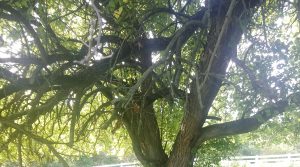
For my focus objects, I chose a drooping branch to the immediate left of me, a small plant next to that branch, and a stick about two feet behind me. I chose the branch because it is the only one touching the ground. It is also splintered at one area and I’m curious as to how it will hold up. The plant is one that I sketched in my journal and I feel it will be interesting to eventually identify it and watch it through the fall. I choose the stick to have a nonliving object to observe, and it seems many ants were already making use of it in some way.
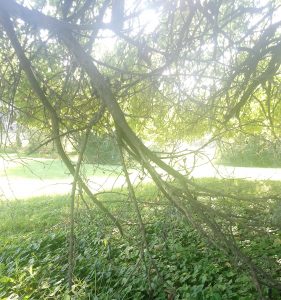

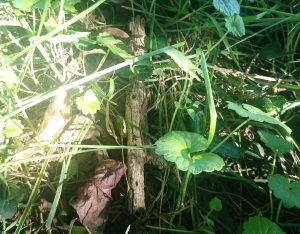
Overall, I felt I had a productive first visit that will be a good base to build the rest of my observations on. I did feel it was difficult to break up what I was observing – it was almost overwhelming trying to write all that I was experiencing, and frustrating when I couldn’t identify certain sounds, plants, or insects. Sounds were easier to focus on, but like other senses it was difficult to distinguish parts from the whole. Smell seemed the simplest because the fresh dampness of the plants was dominant, but even then, I wondered what I may be missing. However, even in the hour spent there it got easier to distinguish things. I am eager to see how the site may look to me on my final trip.

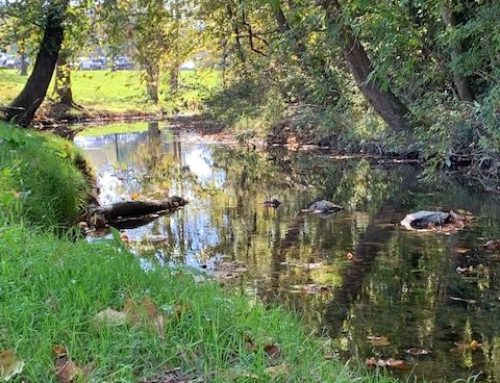
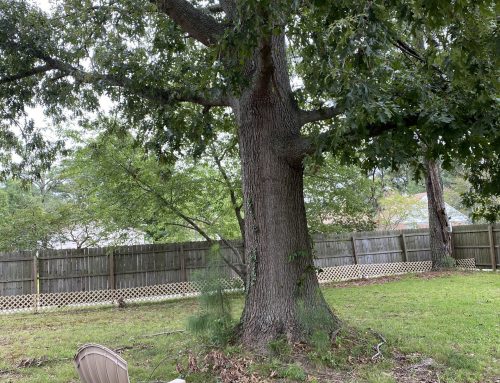
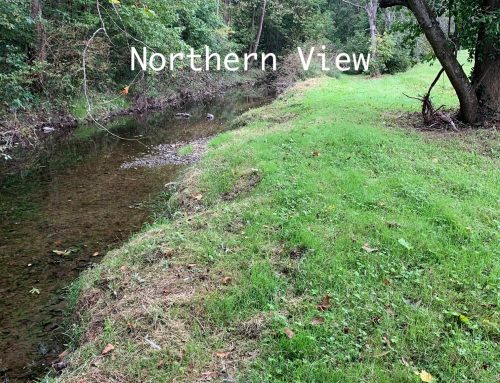
I love this tree Kady and can understand why it drew you to sit under its branches. I think you should try to identify it so that you can learn more and maybe see it in a new light. I look forward to more blog posts from you!
That tree looks so beautiful! Sitting underneath that tree must feel so calm!